Alaska in September: Weather, What to Expect & Seasonal Tips
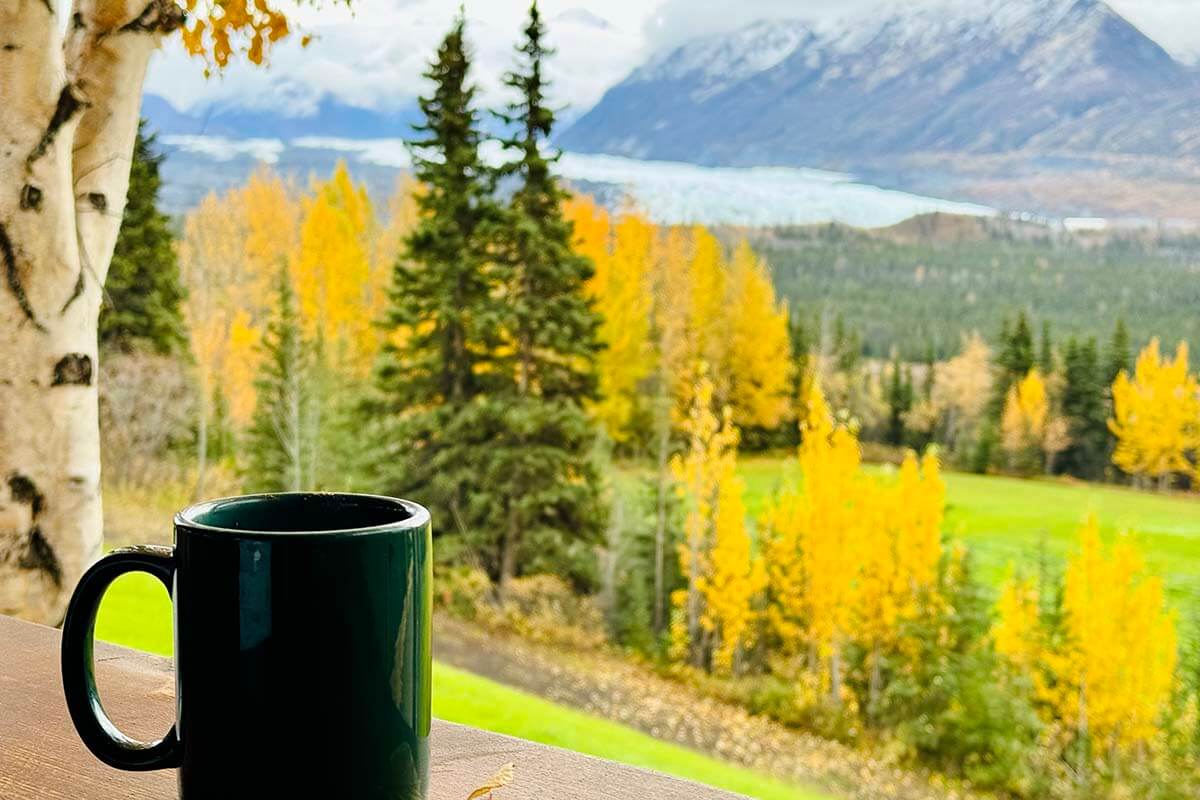
This site contains affiliate links, which means that we may earn a small commission, at no cost to you, for qualifying purchases. It supports the work that goes into keeping this content free. Thanks for reading! More info: Privacy Policy.
Thinking of visiting Alaska in September and wondering what to expect?
What is the weather like? What to wear? Is it a good time for fall colors? Can you see the Northern Lights? Is everything open? How busy is it? Is September a good month for outdoor activities or wildlife viewing? Can you still see bears?..
In this guide, you can find answers to these and other questions, as well as my experience-based tips for your fall visit to Alaska.
I also share the advantages and disadvantages of visiting Alaska in September.
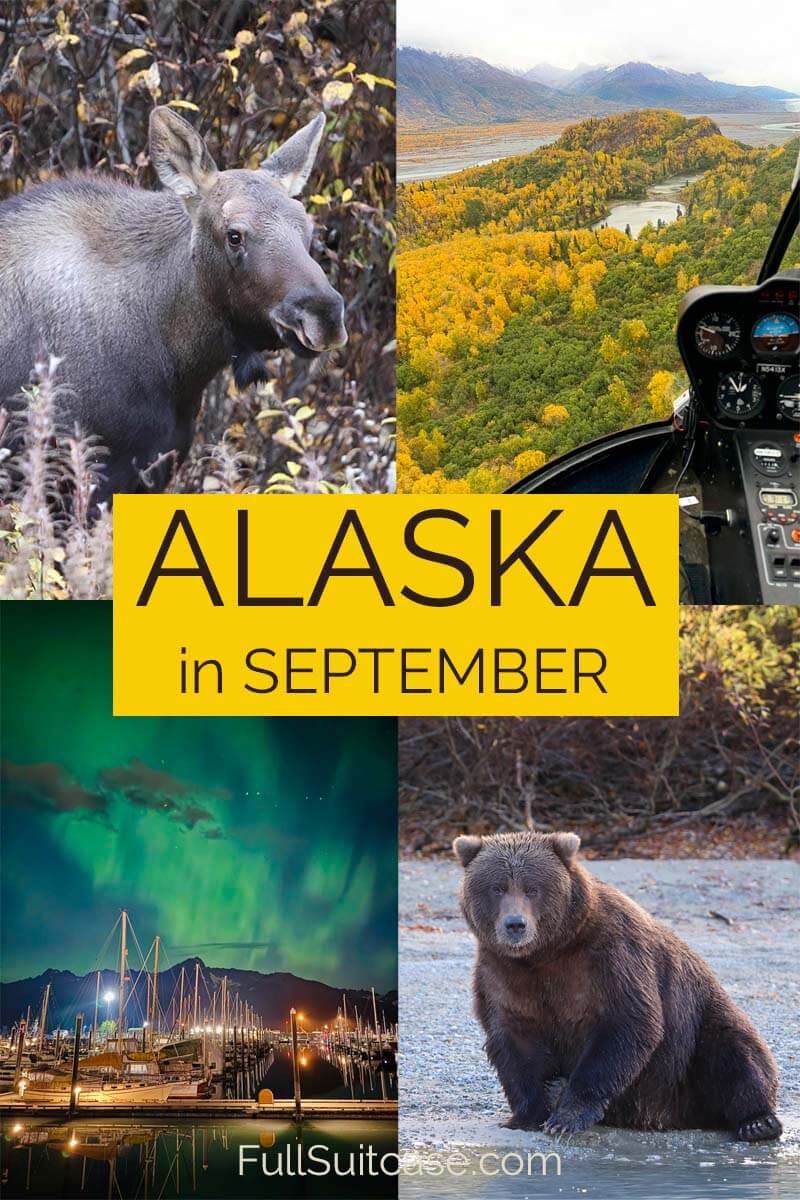
First, let me share my story and first impressions when planning a trip to Alaska in the fall.
It would have never occurred to me to visit Alaska in September. I always heard that the best time for Alaska was June to August. But I was going to attend a conference and there was no way I would fly to the other side of the globe just for two days of meetings. So I wanted to do some sightseeing as well.
When I started researching what I could do in Alaska in the second half of September, I got really worried that it was too late in the season to experience the best of it… I couldn’t find any multi-day group tours that I could join as a solo traveler. There were no cruises. Many hotels and day tours showed zero availability after Labor Day, and even day trips out of Anchorage were limited. Plus, many available tours require at least two people to run a tour.
I quickly realized that planning a September trip would require a bit more research and some flexibility from my side. But I also saw possibilities and quite a few advantages of visiting during the low season… And so I decided to go and make the best of it.
This trip exceeded all my expectations and I am convinced that September is one of the very best times to visit Alaska.
Thus this guide – to share my experience, give you a realistic idea of what you can expect, and help you plan a memorable trip. Find out!
READ ALSO: 2-Week Alaska Itinerary (My September Trip)
Alaska in September – OVERVIEW:
Alaska Weather in September
September in Alaska marks the transition from summer to fall, and the weather reflects that. Expect cooler temperatures, with daytime highs at the beginning of September ranging from 50°F to 60°F (10-15°C) in the south and dipping lower as you head north. There is also a notable difference in temperatures/experiences depending on elevation. It tends to get cooler towards the end of the month too.
Rain is common, particularly in coastal regions, so be prepared for wet weather. Nights can get chilly, sometimes dropping to freezing. Mountain peaks start to get the first snow of the season. They call it ‘termination dust’ because it terminates the summer. It sure adds a nice touch to your photos!
Based on my experience road-tripping in Alaska in the second half of September, I can say that you really have to be prepared for everything. A lot also depends on where exactly you are traveling, but it’s also a matter of luck.
My experience: I visited Alaska in the second half of September. Watching the weather forecast a few weeks before the trip, I saw nothing but grey skies and rain. So I was prepared for that. In reality, I had a bit of everything: mostly beautiful sunny days with blue skies, moments when it was even too warm for a sweater, a few grey rainy days with moments when it was pouring non-stop, and even one day when it was snowing…
Here is just one (a bit extreme) example based on what I experienced in a single day. In the morning, I was in Denali National Park where it was snowing with temperatures just around the freezing point. a 3 hours drive later, I was in Palmer where it was sunny and locals were walking around in shorts, T-shirts, and sandals… Talking of which, I saw locals in sandals on so many occasions in Alaska in September. They said it was still summer…
So what should you pack? See my tips below!
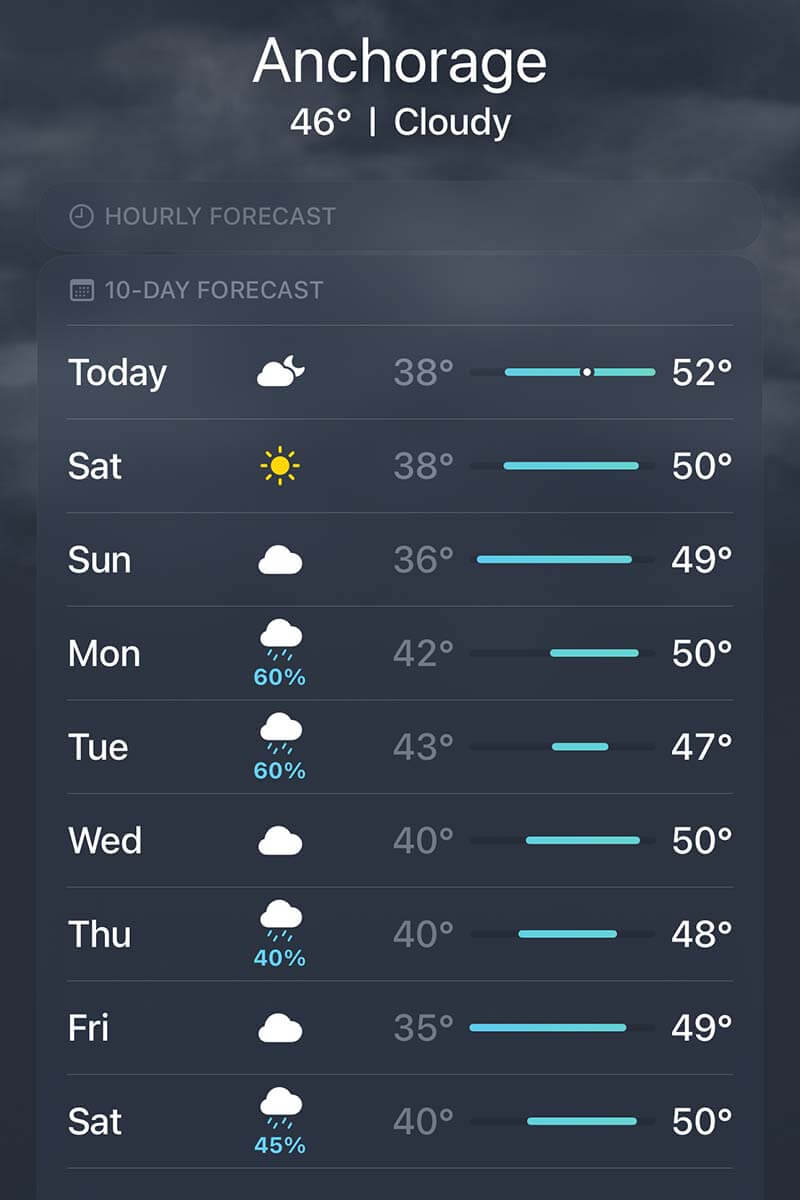
What to Wear
When packing for Alaska in any season, you have to be ready for all kinds of weather. Layers are your best friend, with a waterPROOF outer layer. September is no exception; you just need somewhat warmer layers than in the summer.
I recommend Merino wool base layers, but any moisture-wicking T-shirts or long-sleeved shirts will do. Plus a warm sweater and an insulated waterproof jacket. As for pants, hiking pants are ideal, plus warm leggings. Don’t forget rain pants – it’s truly a must!
A simple rain jacket will be ok for activities like hiking or kayaking, but it will be too cold for boat trips and similar where you really need a wind- and waterproof jacket with sufficient insulation. If you are planning a very active vacation, consider packing two jackets – a thin warm puffer jacket and a waterproof rain jacket – and layer them over each other if needed.
You should also pack a warm hat, light gloves, and a buff or a scarf. Sturdy waterproof boots are essential. If you plan on spending lots of time outdoors, consider waterproof socks as well. Because sometimes you really can’t avoid water getting into your shoes (like rain running into your shoes from the top).
What I packed for Alaska in September: In addition to regular clothes to wear in town or to go to a restaurant (jeans, blouses, sneakers), I packed the typical outdoor gear that I always take to similar destinations (Iceland, Norway, Greenland, Faroe Islands, etc.). I took a few Merino shirts and leggings, a thin wool sweater, a fleece sweater, hiking pants, rain pants, hiking socks, and the best waterproof hiking boots that I own. I also packed thin screen touch gloves, a winter hat, a polar buff, and a warm scarf.
I took two warm waterproof jackets with me (just because I had space and couldn’t decide). Contrary to what I expected, I ended up wearing my warmest jacket pretty much all the time (the same insulated waterproof winter jacket that I also wore to Iceland in winter and Northern Norway in winter). I only wore my thinner jacket for sightseeing in Anchorage, rafting in Seward, hiking in Homer (any jacket was too warm for that!), and summer dog sledding in Willow.
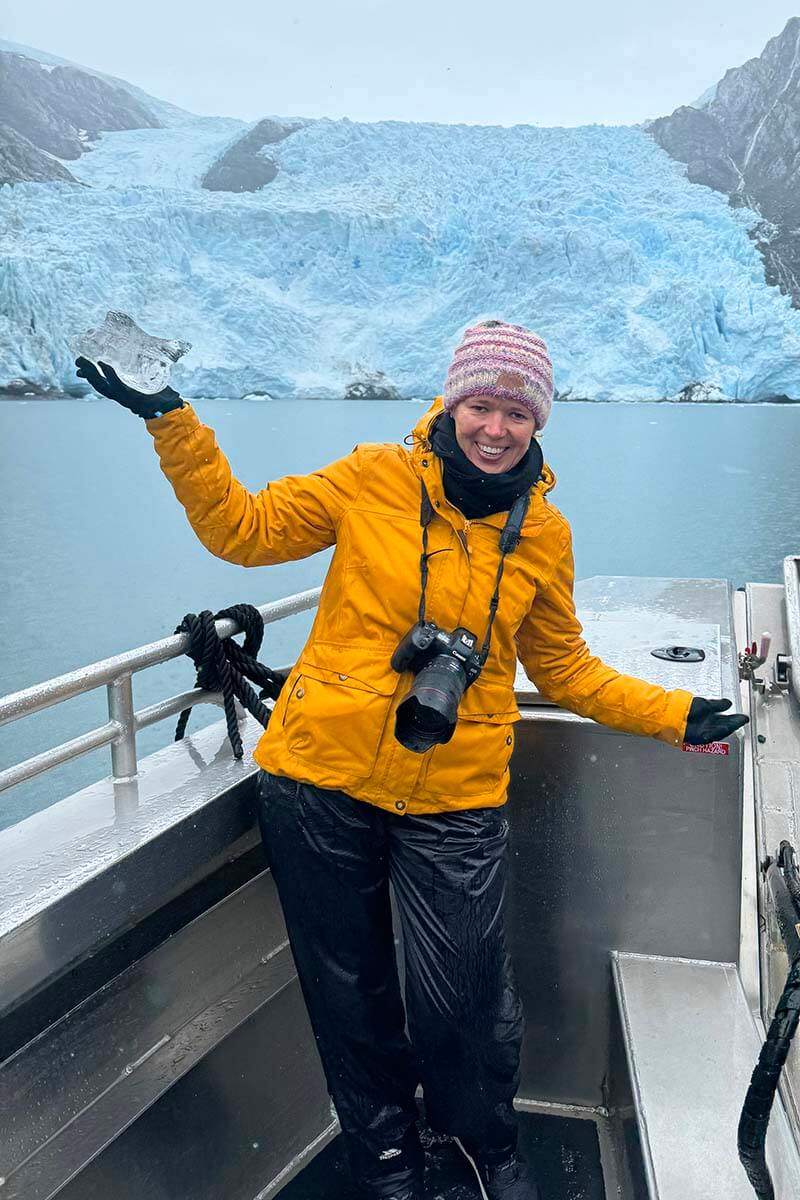
Is Everything Open?
Pretty much everything is open at the beginning of September. But after Labor Day, things start to wind down quickly. Many seasonal businesses, especially in smaller towns, close by mid-September. Some places remain open until the end of September or even early October, but it’s really destination- and activity-dependent.
National parks like Denali remain open, but services operate on reduced schedules and often stop completely by the second half of September.
Many outdoor activities, flightseeing-, and boat tours are still available in September, but there are limited options and fewer departure times. Overall, it’s essential to check operating hours and season-specific information for every place you want to visit. Do your research and be sure to pre-book all the activities you want to do!
Some examples from my experience: I arrived in Alaska on September 14 and took the very last train of the season on the Alaska Railroad from Anchorage to Seward on September 15. In Seward, everything was still open and I did the Kenai Fjords cruise, rafting, etc.
My next destination, Homer, was incomparably quieter and most tour operators had stopped for the season. That said, there was still plenty to do, including boat tours on Kachemak Bay, Grewing Glacier Lake hike, etc.
The quietest place I visited was Denali National Park, around September 20. Pretty much all lodges were closed and activities had stopped for the season. I had to stay half an hour’s drive from the park entrance because there was literally nothing open closer to the park. Luckily, I read in advance that there were no restaurants nearby either, so I bought some food to take with me.
Overall, there are still enough hotels and restaurants open and there is plenty to see and do in Alaska in September, including some of the most epic experiences – see below. It only requires a bit more flexibility and research.
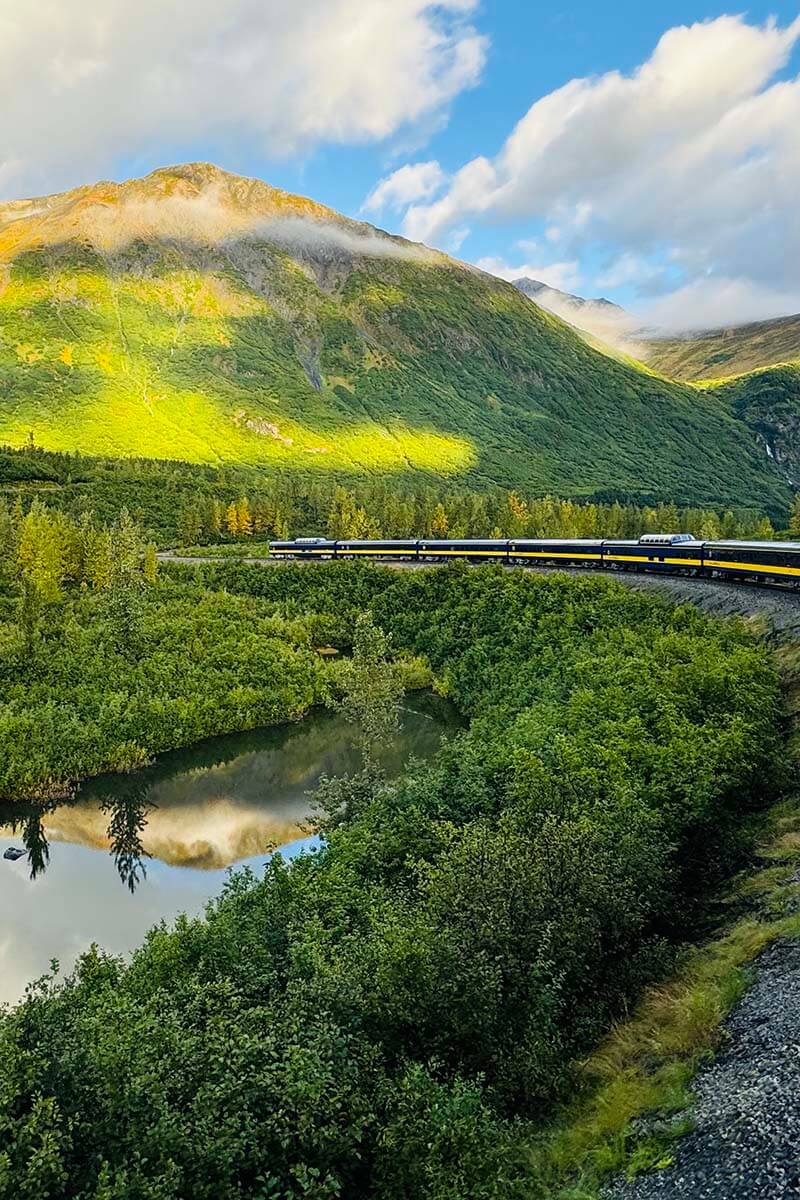
What to See & Do in September
In September, you can do pretty much everything that you can do in Alaska in the summer. If there are any limitations, it’s usually not that much because of the weather, but because many businesses are closed due to low demand.
Plus, September also offers something that you can’t experience in summer – mainly fall colors and Northern Lights! See further below for more information!
You can go hiking and do all kinds of outdoor activities, boat trips, etc. I did lots of tours, pretty much every day, and they were epic. From hiking and rafting to boat trips and flightseeing tours – you can experience the very best that Alaska has to offer in September (and without the crowds!).
Some of my favorite tours were Denali flightseeing with glacier landing (Alaska’s #1 tour), Knik Glacier helicopter tour, Kenai Fjords National Park, Matanuska Glacier hike, and Prince William Sound Cruise. By the way, weather permitting, many of these tours are available year-round.
September is also a great time for wildlife spotting! You can see lots of moose everywhere (just don’t get too close to them because they are particularly anxious during their rut season). There is also plenty of marine wildlife – sea otters, seals, sea lions, but also dolphins and some whales.
Bears are preparing for hibernation but aren’t asleep yet. I took this flightseeing tour to see bears at the very end of September and we saw dozens of them! PRO TIP: If you book any flightseeing tour with Fly Rust’s, go via the link above and use code ‘fullsuitcase’ for a 10% discount).
LEARN MORE: Bear-Viewing Tour in Lake Clark National Park
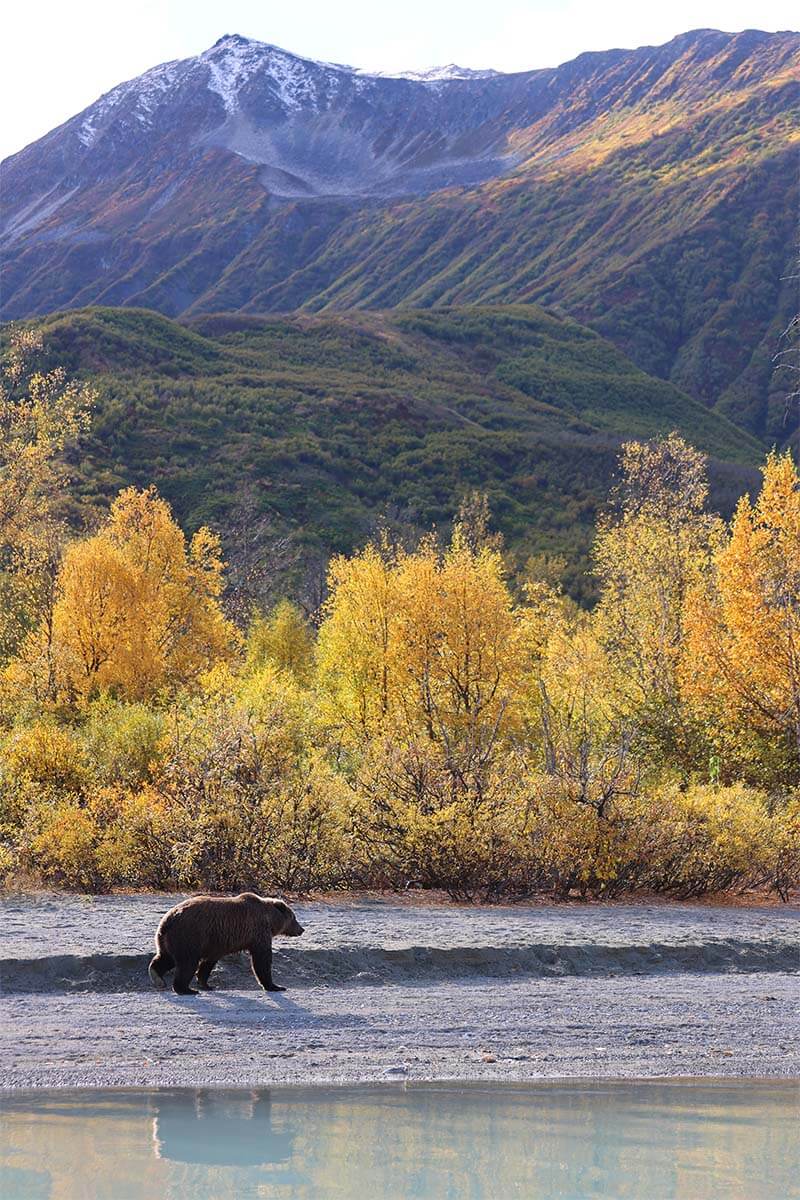
Northern Lights
As the days get shorter and the nights are dark enough, September is also a great time to see the Northern Lights in Alaska.
Even if solar activity is low, if the sky is clear and it’s dark enough, you can see amazing auroras all over Alaska. Just keep an eye on the forecast and if it’s not cloudy, go outside and wait.
The good thing about aurora hunting in September is that it’s usually not that cold yet, so you can comfortably stay outside for a longer time while waiting for them to appear.
Good to know: The highest chance to see auroras is close to the Aurora Oval. In Alaska, this means going to the area around Fairbanks, which is one of the absolute best spots to see auroras in the world. If seeing the Northern Lights is a top priority for you, be sure to add a few nights in Fairbanks to your itinerary.
My experience: I didn’t travel as far north as Fairbanks, but I saw the Northern Lights multiple times during my two-week Alaska trip. In fact, the best auroras I saw were in the south – in Seward. So you just never know. And if I had made more effort, I could have seen them pretty much every night (but one has to sleep once in a while too ;)).
READ ALSO: How to Photograph the Northern Lights
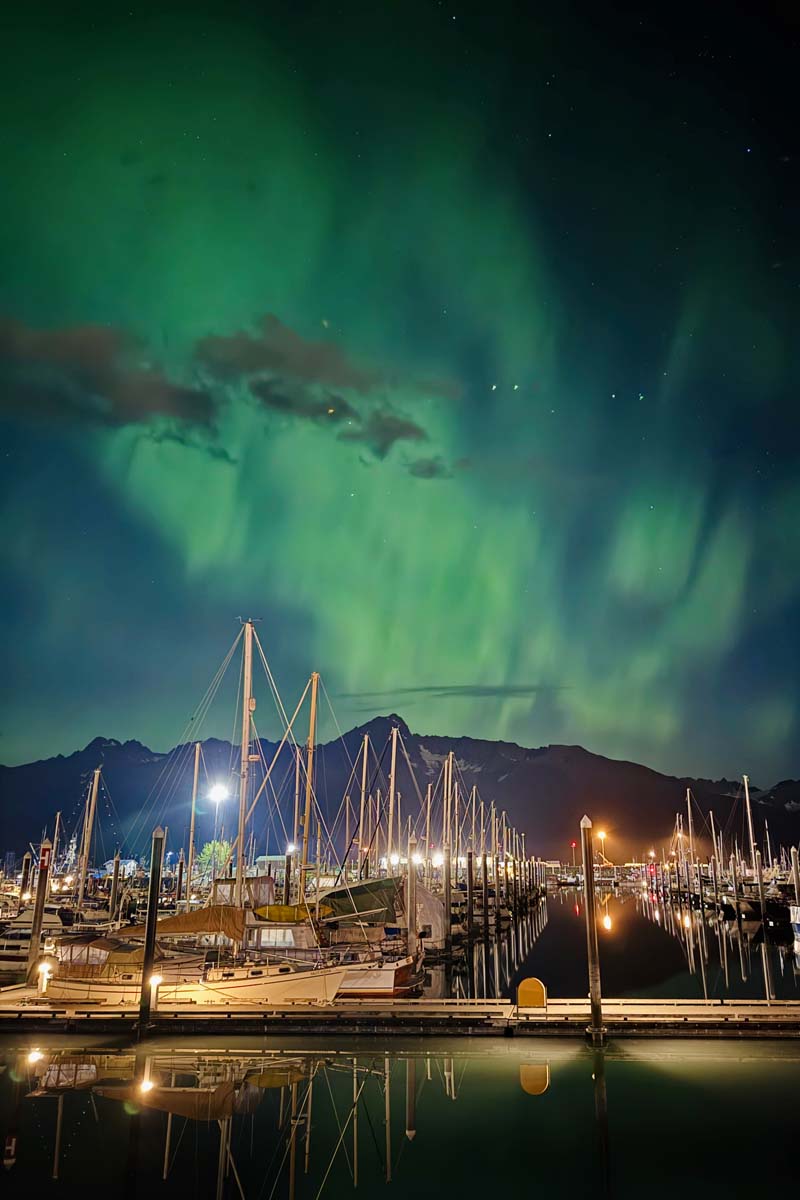
Fall Colors
One of the highlights of visiting Alaska in September is the vibrant fall colors. The scenery is absolutely stunning, with shades of gold, orange, and red making everything look like a real-life painting…
With so much color in the landscape, every drive or hike becomes an unforgettable experience. Not even to mention the most epic tours where fall colors take the already phenomenal experience to yet another level.
Good to know: In interior and northern regions, such as Denali National Park and the Arctic, fall colors come much earlier (already in August). That said, I still saw plenty of reds and oranges in Denali, right before it all got covered by snow… In the meantime, fall colors in coastal areas like Seward and Homer are at their best in the second half of September.
I am convinced that fall colors were one of the reasons why Alaska impressed me so much more than I had expected. The mix of changing foliage and soft autumn light also makes September a dream season for photography enthusiasts.
Talking of light, you may wonder how long are the days at this time of the year – see below!
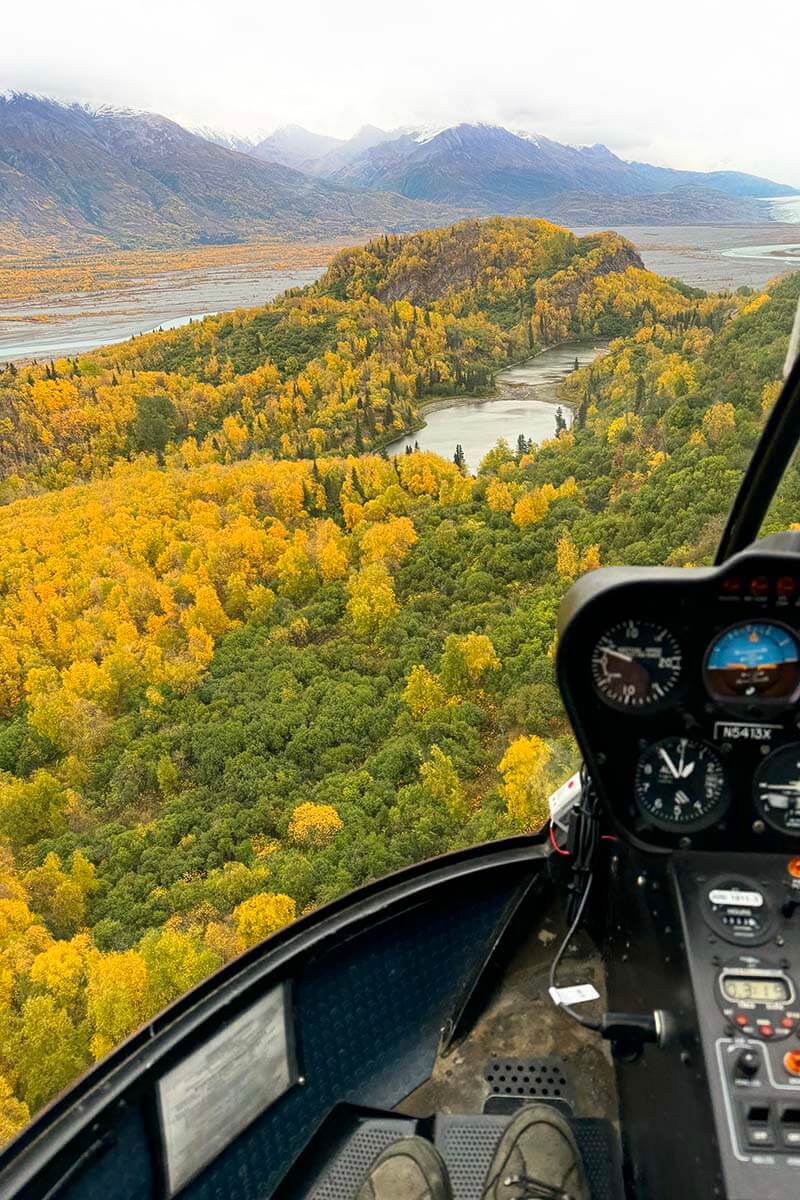
How Much Daylight Is There
Alaska is a big state and days get increasingly shorter towards the end of September. So how much daylight you have depends on where and when exactly you are visiting.
For example, at the beginning of September in Anchorage the sun rises at around 7 am and sets around 9 pm. By the end of the month, sunrise is around 8 am, and sunset is around 7.30 pm (that’s about 2.5 hours of daylight less, in the course of a few weeks).
That said, even at the end of September, there is still plenty of daylight to enjoy Alaska to the fullest. If you are worried about driving in the dark, simply start your days a bit earlier.
On the positive side, you don’t have to get up very early to catch a sunrise or stay up late to see the most amazing sunsets.
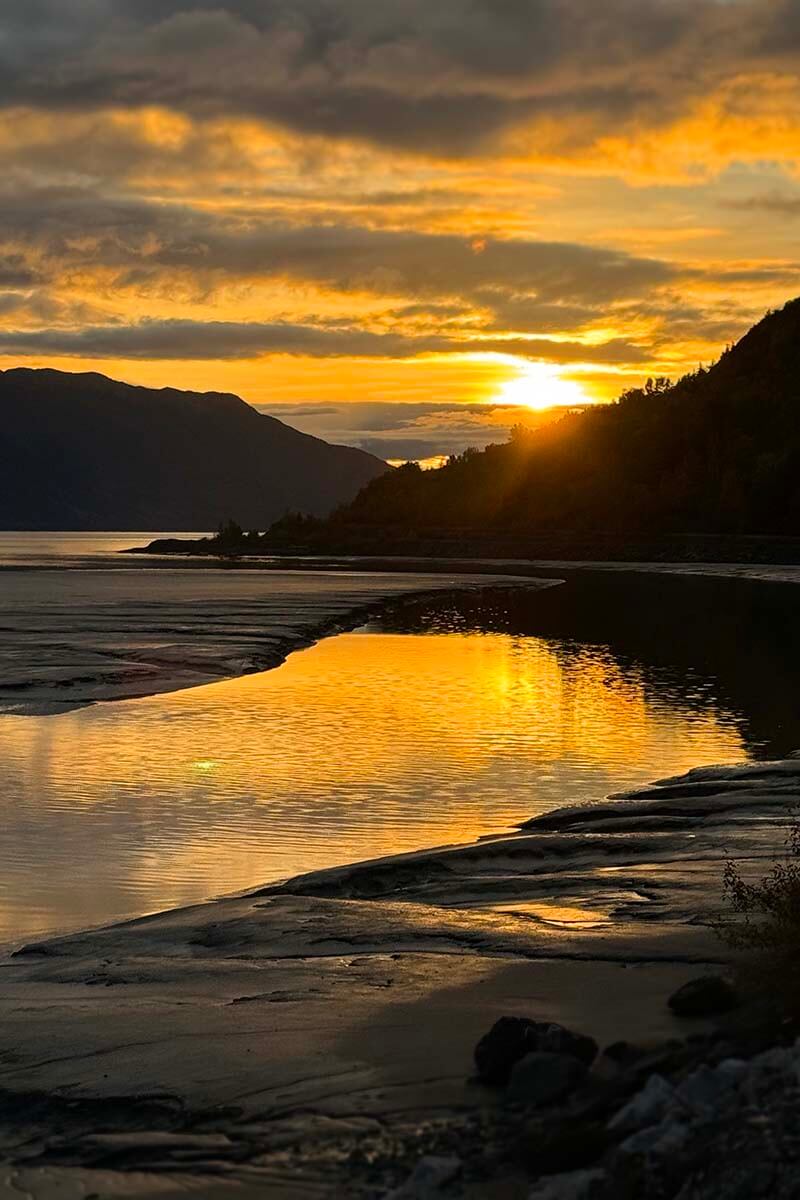
Denali National Park in September
Denali National Park can still be very lively at the beginning of September but is practically deserted by the end of the month. You can still go hiking and might get lucky to see wildlife such as caribou, bears, foxes, or wolves. However, winter comes early here, so by the end of September, everything might be covered in snow…
Early in the month, you can still access much of the park via shuttle buses, but bus service ends the second Thursday after Labor Day. Alaska Railroad service between Anchorage and Fairbanks via Denali typically stops mid-September, and that’s also when most facilities around Denali National Park close. (There is also limited winter service on the railroad line between Anchorage and Fairbanks, but Fairbanks is a super popular winter destination, whereas Denali is deserted).
Good to know: When buses are running, you can only drive the first 15 miles of Denali Park Road in your car. After the bus service ends, you can drive to Mile 30. The road remains open more or less until half-October unless snow and ice close it earlier.
Denali National Park spans different elevations, so road conditions and fall colors depend on where you are. At the highest elevations, fall colors start in early to mid-August already, and they spread to the rest of the park by Labor Day.
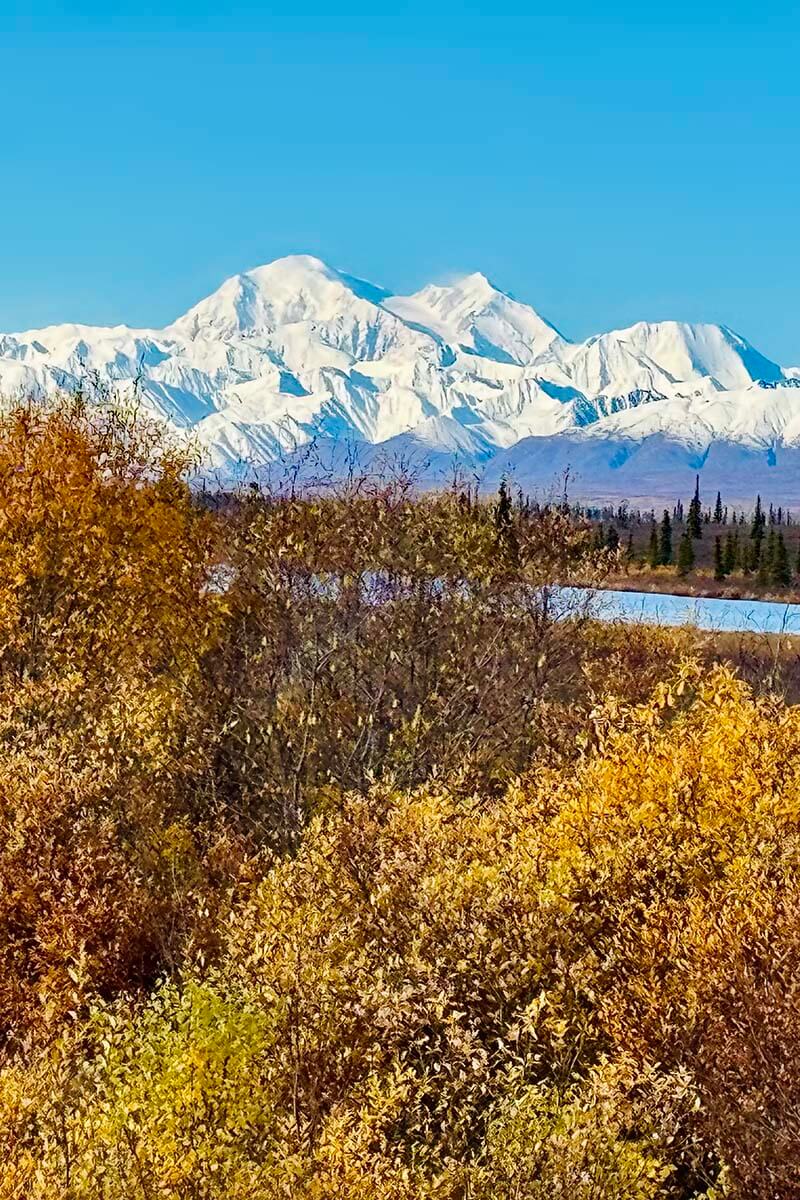
My experience: I had about two days for Denali National Park on my itinerary and visited here around September 20-22. As already said, all hotels near the park were closed, so I stayed about half an hour’s drive away.
The day I arrived, it was sunny around Mt Denali itself (I went on a flightseeing tour and it was spectacular!), but it was rainy and grey at the National Park entrance. The fall colors were stunning – with some yellow trees at lower elevations and a dark red tundra landscape a bit further into the park.
When I returned to the park the next morning, however, I found that winter had arrived overnight. The further I drove, the colder it got. Soon, everything around me was covered in snow, and driving conditions became too dangerous to continue in a rental car with summer tires… So I turned back and returned to Anchorage earlier than expected. It was on that same day that I met people wearing shorts and T-shirts in Palmer…
TIP: If you are planning a September trip to Alaska, try to plan your visit to Denali National Park before mid-September, or at least as early as your itinerary allows it. Also, check the official website for up-to-date information and current conditions.
READ ALSO: Denali Flightseeing (Alaska’s #1 Tour)
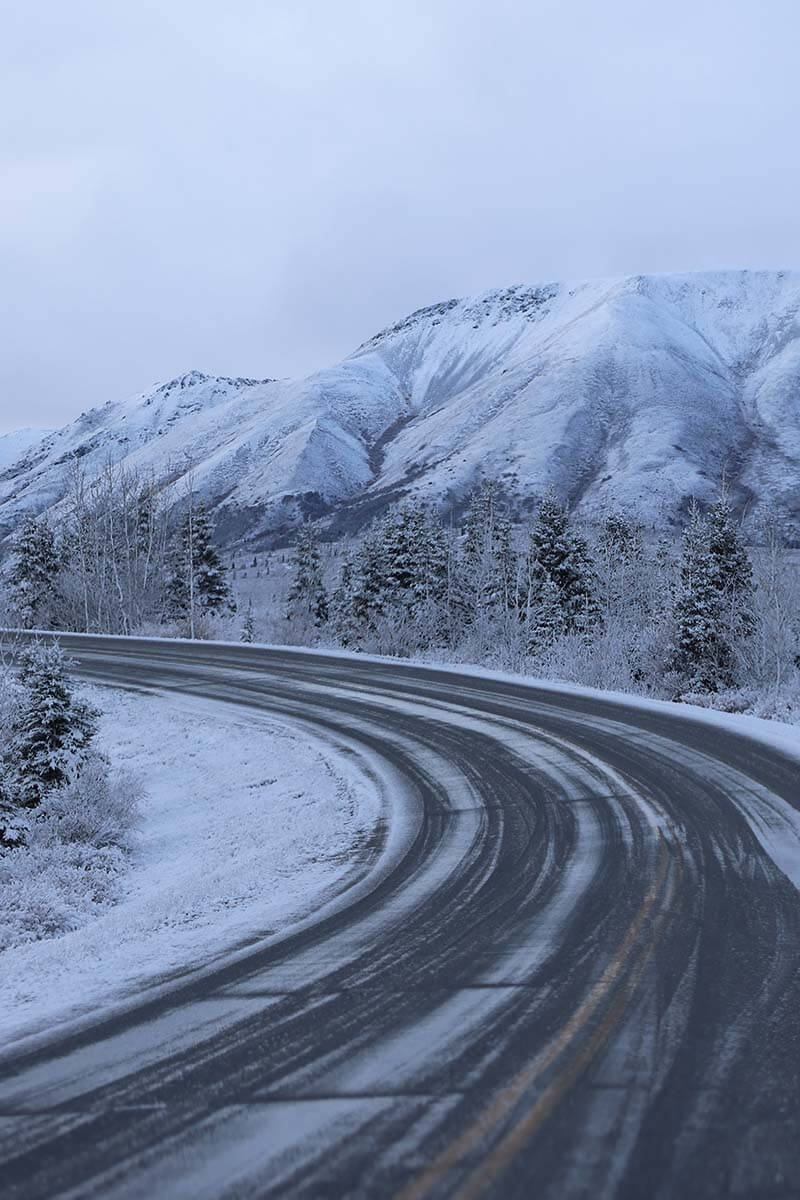
Roads & Driving Conditions
Driving in Alaska in September is generally nothing to worry about. Most major roads are still in excellent condition.
However, snow can appear at higher elevations later in the month, especially on routes like the Denali Highway or Hatcher Pass. So keep an eye on the weather forecast, and adjust your plans if needed. Also, if you’re planning to explore remote areas, ensure your vehicle is equipped for changing conditions.
Good to know: Most car rental companies in Alaska don’t bother changing to winter tires and don’t allow driving on gravel roads. So do your research – depending on your itinerary and what you plan to do. Overall, in September, you should be fine in a regular car without any special winter gear.
My experience: I found driving in Alaska super easy and extremely rewarding. The main roads are good, there is little traffic, and the scenery is rewarding. Apart from the snow on Denali Park Road (which I quickly left), I didn’t encounter any problems anywhere.
That said, I did adjust my plans once when locals told me that there were 6 inches of snow at Hatcher Pass. I ended up doing the Knik Glacier helicopter tour and it became one of my favorite experiences of the entire trip. So no regrets there at all.

Advantages of Traveling in September
There are quite a few advantages of visiting Alaska in September. Here are the main ones:
- It’s a bit like summer. The weather can be just as nice as in the summer and you can do pretty much all the same activities as in the summer months.
- Fewer crowds. You can have the most popular spots practically to yourself.
- Lower prices. Flights, hotels, and car rental are significantly cheaper in September than in the summer. In the second half of September, I paid about 1/2-1/3 the price for the hotels, and also rental car was about 1/3 of the summer rate. That said, you have to book ahead because availability is limited.
- More flexibility. With a bit of luck and flexibility, it’s possible to book many experiences last minute. That said, if you absolutely want to do something and don’t want to risk missing out on the experience, you have to reserve in advance. For example, the Alaska Railroad tickets were sold out (book in advance!), bear tours weren’t easy to arrange, and I encountered quite a few other things where it was essential to plan/book ahead.
- Fall colors. I can’t imagine a more scenic time to visit Alaska than in September. The colors really bring the landscape to life.
- Northern Lights. September is the only month where you can experience both – summer activities as well as auroras.
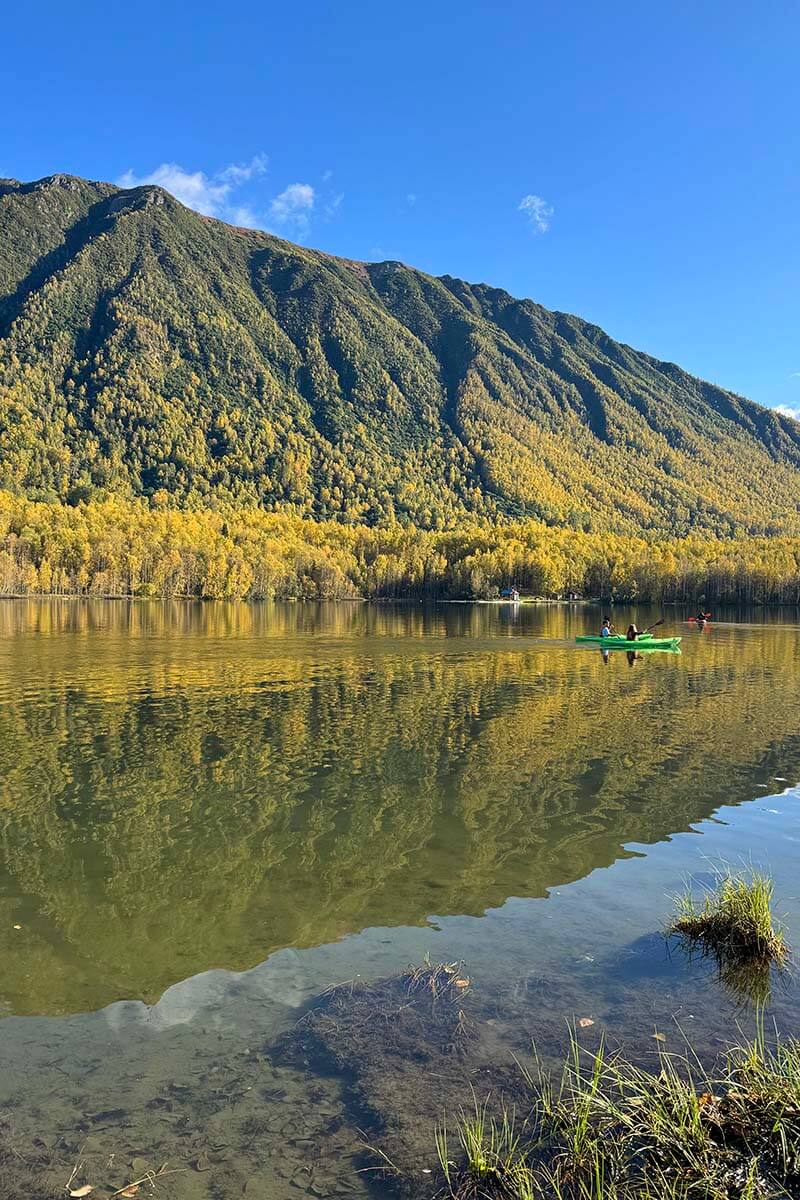
Disadvantages of Visiting Alaska in September
The main downside of September travel is that many seasonal businesses and attractions close or operate on reduced schedules, limiting your options.
Road conditions can also become challenging in certain areas, but if you stick to the main roads, it shouldn’t be a problem yet.
As for the weather, yes, it can change quickly and can be cold and wet, but that’s something you can never predict in Alaska. You just have to take a chance.
My friends spent three weeks in Alaska in August and had rain almost every day. In the meantime, I visited in the second half of September and had blue skies and sunshine on most days, with just two really rainy days. So you really never know, and the weather will likely change at least a few times a day anyway.
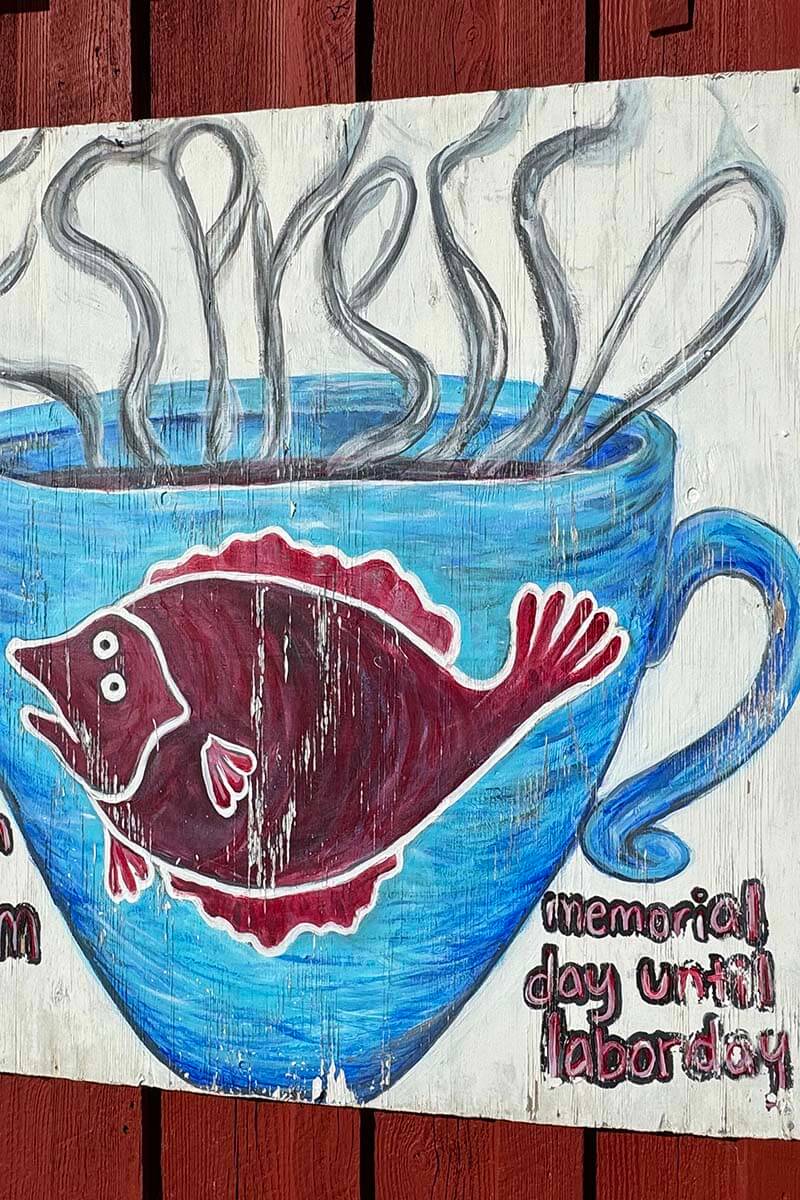
Final Thoughts
In my opinion, September is one of the best months to visit Alaska. While there are some disadvantages – like seasonal closures and unpredictable weather – I find that the advantages far outweigh any drawbacks.
It’s a quieter time without summer crowds, with stunning fall scenery, abundant wildlife, and the added bonus of the possibility of seeing the Northern Lights. Local communities are welcoming, and with lower prices compared to summer, your budget goes much further.
I wasn’t sure what to expect in Alaska in September but I loved every minute of it (even the rain and the snow because that makes for some fun memories ;)). I would return in a heartbeat!
TIP: Planning a trip and looking for more information and inspiration? Check out my guides to some of the best places and experiences in Alaska:
- Alaska Road Trip Itinerary
- Anchorage Day Trips & Excursions
- Anchorage 1-Day Itinerary with Top Things to Do
- Destination Guides:
- The Most Epic Experiences:
TIP: Did you find this guide helpful? Bookmark this post for later, share it with your friends, and save it to Pinterest to inspire your next trip.
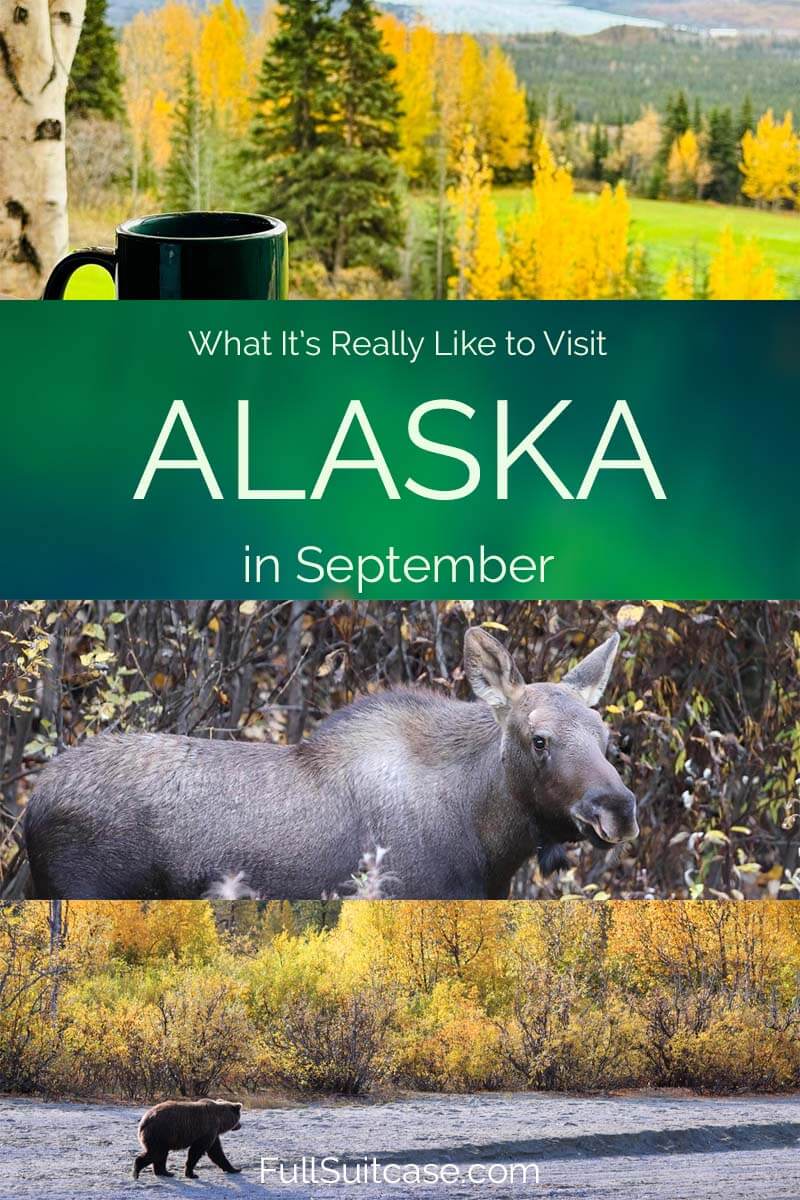
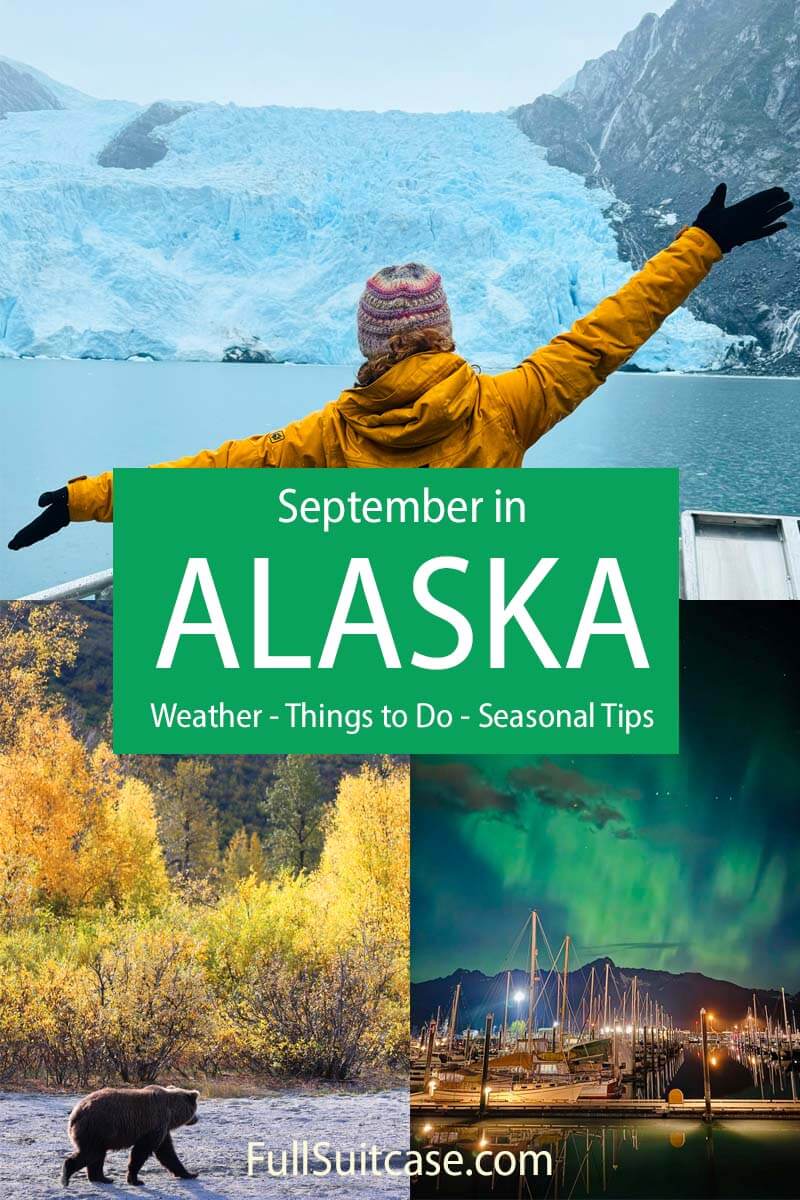


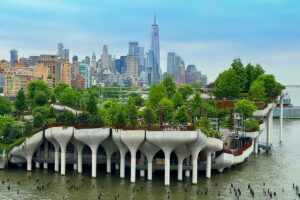
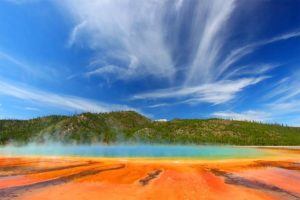
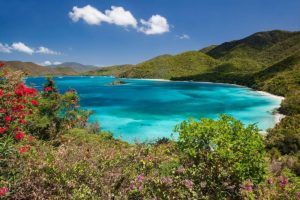
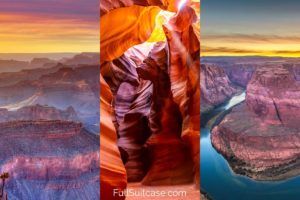
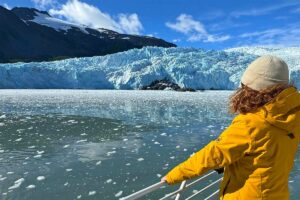
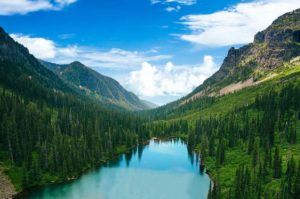
Thank you for sharing!😍
Glad to help, Noel. Have a great time in Alaska!
Great read! I am looking at putting together a trip at the end of this month August into September for 2 weeks. You mentioned the key to seeing Alaska in September is flexibility. I am trying to figure out how to maintain a flexible itinerary when almost all the lodging reservations are non refundable. For example, I was thinking of going to Homer for 2 nights to take a bear flightseeing tour. But if weather does not cooperate, would it be a safer bet to set up base in Anchorage and take tours from there when the weather is good? By the way, your two week Epic Alaska Road Trip Itinerary is very similar to the one I am planning with 2 to 3 days to Fairbanks (instead of Talkeetna) if the aurora forecast looks good. Would love to hear your strategy.
Hi Dew, in my experience, traveling in Alaska always requires some flexibility – whether you’re going in July or late August or in the fall. The weather is unpredictable, can vary a lot between regions, and often changes quickly. So yes, tours can get canceled last minute or adjusted on the go, no matter when you visit. That said, I have been on some amazing tours in a pouring rain too – it doesn’t always have to be a dealbreaker.
I’d book the things you really want to do in advance, especially those with limited availability (like bear viewing tours). At the same time, have a few backup ideas in case something gets canceled. For example, if a bear flight from Homer doesn’t happen, you could do a scenic boat trip in Kachemak Bay and/or hike to Grewingk Glacier Lake.
And yes, sure, you can also use Anchorage as a base and do tons of amazing day trips from the city, including bear viewing tours. It’s really your preference and depends on your travel style, whether you want to rent a car, etc. Just remember that the weather in Anchorage doesn’t tell you anything about the weather in other places, so you may leave in sunshine and get caught in the rain, or vice versa.
My personal strategy is always to build a trip I want to do and book everything I really don’t want to miss in advance, assuming it will go smoothly, and stay flexible if plans need to shift. I’ve found that leaving things too open can create more stress than it’s worth, mainly because you end up spending a lot of time planning and adjusting instead of enjoying your trip. Plus, you risk missing out on some things entirely, and things can still change at the very last minute too. Some of our most memorable travel experiences have actually come from moments when things didn’t go exactly as planned – that’s all part of the adventure.
Hope that helps. Have a fantastic trip!
This is such a great guide! I never would have thought that Alaska could be just as good in the second half of September as it is earlier in the summer months. I took a trip to Alaska years ago and I’ve been wanting to go back as soon as work allows. There are a few things on your list that I missed the last time, so I’m definitely going to need to make some time to hit them as well. Thanks so much for sharing!
Alaska is definitely worth a repeat trip if you get a chance, and September is a great time to go!